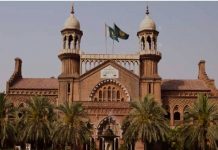From Abid Usman
LAHORE: In response to predictions of “moderate to very heavy rains” during the monsoon spell this year, the Punjab government has put relevant authorities on alert.
The provincial government took this action after the National Emergencies Operation Centre (NEOC) issued a weather advisory about “more than normal rains”.
On directives of Punjab Chief Minister Maryam Nawaz for making arrangements amid prediction for heavy showers, the Provincial Disaster Management Authority (PDMA) has ordered all relevant de-partments to remain alert.
Starting in July’s first week, monsoon rains would likely affect many parts of Punjab, said the PDMA. Downpour of 15 to 55 millimetres are forecast in the divisions of Rawalpindi, Lahore, Sargodha, Faisala-bad, and Gujranwala. According to the weather advisory, showers in the divisions of Multan, Dera Ghazi Khan, and Bahawalpur are predicted to be less intense and of short period.
Monsoon activity will persist in Rawalpindi, Gujranwala, Sargodha, Lahore and Faisalabad divisions where 25-35mm rains are predicted. Isolated rains are also expected in Multan, DG Khan and Baha-walpur Divisions. Rain spells will remain significant in upper Punjab, while there will be a noticeable de-crease in downpours in central and south Punjab as the monsoon enters a weak phase.
The advisory added that aforesaid parts are expected to receive 15-25mm rains. Rawalpindi, Lahore, Sargodha, Gujranwala, and Faisalabad divisions are likely to face flooding due to heavy rains, from 50-70mm, whereas, hill torrents in DG Khan Division are expected. “Moderate to heavy rains” are also forecast for the Sahiwal, Multan and Bahawalpur divisions.
The PDMA also warned about perceived impacts of the moderate to very heavy rains which “may in-crease water flows in local nullahs, streams, rivers causing riverine and flash flooding in vulnerable are-as”. It added that very heavy downpours may trigger hill torrents in vulnerable areas of DG Khan, Ra-janpur and along Sulaiman range.
It may also cause urban flooding in vulnerable urban areas across the province, whereas, some areas of Murree could see landslides. Dust storms, wind-thunderstorms and heavy falls may cause damage to loose structures such as electrical poles, solar panels, boardings, tall trees and under-construction buildings, it concluded.





